The Proto-Bulgarians east of the Sea
of Azov in the VIII-IX cc.
During the expansion of the Khazars most of the Proto-Bulgarians remained
in their lands and submitted to the Khazars. The Arab invasions of the
20's and the 30's of the VIII c. did not influence significantly the situation
either. Most severely affected were the Alans of the central Fore-Caucasus.
A part of the Proto-Bulgarian population of the eastern Fore-Caucasus,
from the lands between the rivers Sulak and Terek, also had to migrate
to the lands of their kinsmen along Don and the Sea of Azov. It is quite
possible that the Barandzhars, who were mentioned in 922 AD by ibn-Fadlan
as living among the Volga Proto-Bulgarians, had been immigrants from Northern
Dagestan, where they have been known to the eastern chroniclers as Belendzheris.
As it might be, up to now there are no sound archaeological proofs attesting
the presence of Proto-Bulgarians from Dagestan in Volga Bulgaria. It makes
us conclude that at that time the Unogundur-Bulgars of the khan Batbajan
still occupied the lands to the east of the Sea of Azov.
The documentary sources do not reveal the exact location of the Unogundurs
of khan Batbajan, they had probably occupied the lands along the eastern
coast of Azov as well as the lower course of Don. The latter is confirmed
by the northerly oriented graves in Sarkel, in the Semikarakarskoe gorodishte
and especially in the Artjuganski necropolis. These graves, although, might
also belong to remains of the retreated to the west Unogundurs of khan
Asparuh. There cannot be a definitive answer to this problem, the Armenian
geography, besides the Unogundurs, mentions other, less numerous Proto-Bulgarian
groups in the lands of eastern Fore-Caucasus, but the area is still poorly
studied and any further delineation of the various Proto-Bulgarian groups
is not possible at present.
The principal data about the Proto-Bulgarians of Azov come from the
early medieval horizons of the two towns of the Taman peninsula - Phanagoria
and the Tamanskoe gorodishte. The end of the VII c. and the beginning of
the VIII c. evidenced the revival of Phanagoria, there was a massive influx
of a new population, the streets of the town were re-planned. New buildings
with stone foundations and brick or clayey walls appeared. The foundations
were constructed in the new 'pine-tree' technique [1],
characteristic for Caucasus (and for the Chirjurt gorodishte on the river
Sulak). The town flourished in the VIII-IX c., when it became an important
centre of administration and crafts. During that period the Proto-Bulgarians
were its major inhabitants, as it is evident by the brachyocranic skulls
of type 'Zlivki', by the pottery type and by the widely practised 'pine-tree'
building technique. Phanagoria existed up to the end of the IX c. when
it was destroyed by fire and abandoned, most probably after a Pecheneg
invasion.
Almost identical was the picture in Tamanskoe gorodishte [2],
but contrary to Phanagoria, it was revived to life and continued to exist
as an important centre in the next centuries under the name Matarkha -
Tamatarkha - Tmutakaran.
In the scholarly literature the Kuban Bulgars are often identified with
the Kupi-Bulgars of the Armenian geography [3] and are
clearly distinguished from the Unogundurs-Bulgars (Oghondor = Olhontor-Blkar),
the latter thought to be the Bulgars of Azov. Therefore, the Kupi-Bulgars
had probably inhabited the lands south of the Unogundurs, along the lower
and the middle course of Kuban up to the foothills of the central Fore-Caucasus.
It seems that the Pashkovski and Jasenovopoljanski necropolises belong
to the Kuban Bulgars, because of the western orientation of the graves.
To them are often attributed the frequently found in the central Fore-Caucasus
ceramic cauldrons with inner lugs [4]. Kuznecov assumed
that these cauldrons, found in many locations around Kislovodsk were left
by Proto-Bulgarians, who settled in these abandoned by the Alans lands
at the end of VII c. The idea of the penetration of proto-Bulgarians in
the central Fore-Caucasus was further developed by J. Fjodorov and G. Fjodorov,
who pointed that similar caudrons are also found in Karachaevo-Cherkessia
and Kabardino-Balkaria [5]. Kovalevskaja, however, dated
these cauldrons to the X-th c. and attributed them to later nomads - Pechenegs
or Cumans [6]. Although Kovalevskaja may be right to
a certain extent, her negation of the Proto-Bulgarian character of some
of the cauldrons fails to explain the fact that similar cauldrons with
inner lugs appeared no later than at the end of the IX c. in Danube Bulgaria
- at the pottery production centre near the village of Topola, the district
of Dobrich (Tolbuhin) [7]. There is no doubt that some
of the fleeing from the Khazars Proto-Bulgarians from Azov settled in the
suitable for cattle-breeding lands of central Caucasus, which were emptied
by its previous inhabitants - the Alans. As Proto-Bulgarian are interpreted
three pit necropolises on Kabardino-Balkaria - near the aul of Zilgi, at
the right bank of the river Kardan and at the hill of Keshene aly near
the village of Sovetskoe (Kashkatau) in the valley of the river Cherek
[8].
The graves are of western and south-western orientation. In one grave at
Keshene aly the legs of the deceased were apparently bound. The way of
burial and the grave artefacts in these necropolises are quite distinct
from the local culture of north Caucasus and have parallels with the 'Zlivka'
type necropolises [9].
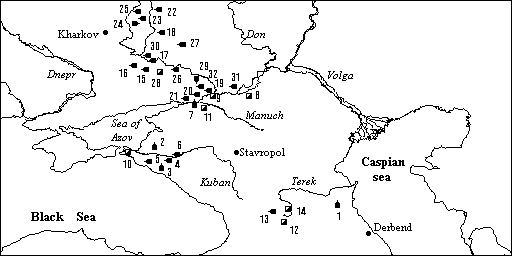
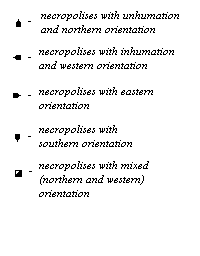
A map of the Proto-Bulgarian necropolises in Eastern Europe in the
VII-IX cc.
1. Verhnij Chirjurt; 2. Novo-Labinskaja; 3. Borisovo;
4. Pashkovskaja; 5. Djurso; 6. Jasenovaja poljana; 7. Artuganovo; 8. Sarkel;
9. Semikarakori; 10. Phanagorija; 11. Bagaevskaja; 12. Zilgi; 13. River
Kardan; 14. Sovetskoe (Kashkatau); 15. Zlivki; 16. Zalimanie; 17. Shejkovka;
18. Pokrovskoe; 19. Krimskij; 20. Krivjanskij; 21. Nedvigovskij; 22. Volokonovka;
23. Jutanovka; 24. Netajlovska; 25. Dmitrievka; 26. Zholtoe; 27. Novolimarevka;
28. Dronovka; 29. Kamensk; 30. Majaki; 31. Right-bank Cimljanskoe; 32.
Gukovo
(The map was produced using XEROX Map Viewer)
Up to now the finds from the mountain valleys of Kabardino-Balkaria
are scarce and insufficient to confirm the Proto-Bulgarian presence. But
there is remarkable centre of the Kuban Bulgars in the upper course of
Kuban - the Humarin gorodishte. It is situated at the high right
bank of Kuban near the aul Humara and at 11 km to the north of the town
Karakachaevsk. The fortress guarded the approaches to the Kluhor pass,
connecting the Kuban valley with Sukhumi at the Black Sea coast [10].
The gorodishte occupies a narrow and long hill surrounded by deep ravines
and is linked with the high plateau by a narrow neck. The enclosed by the
walls area was up to 840 m long and 480 m wide, or nearly 250 decares.
Kuznecov published several runic inscriptions and symbols from Humarin
in 1963 [11] and since 1974 there began systematic
archaeological excavations [12]. The excavations revealed
a 5-6 m thick fortified wall running at the edge of the hill, built of
ashlar blocks with dimensions 0.9 x 0.4 x 0.3 m and 0.5 x 0.35 x 0.2 m,
sometimes up to 1.4 x 0.3 x 0.2 m. The blocks were larger near the towers
and at the lower part of the walls. These were no foundations - the walls
were laid directly on the levelled ground. The facing was always of carefully
cut rock blocks, the inner volume of the wall being filled with not so
regular blocks. Usually the first row of ashlars was laid breadthwise,
the next row - lengthwise, and so on. Clay was the main soldering agent,
mortar being used only for the outer lower facing wall. There were 20 equidistant
towers along the wall and the high point in the eastern end of the fortress
was modelled as a citadel.
Next to a rectangular tower in the south-western end of the fortress,
at the foot of the citadel there was unearthed a small, but intriguing
building, built later than the fortress. It represents a rectangular single
chamber, 7 m long and 6.2 m wide. Its 0.75-1.0 m thick walls consist of
very elaborately cut ashlar blocks. In the centre of the room there
was a levelled square platform (2.5 x 2.4 m), shouldered by a double line
of ashlar blocks. The clayey platform bears the signs of fire and the whole
building is oriented towards the summer sunrise. All points it had religious
functions, it can be compared with the Zoroastrian shrines in which the
altar with a burning fire occupied the central place. The described previously
pagan beliefs of the population of the town of Varachan, the capital of
the 'Kingdom of the Huns' illustrated the religious syncretism between
the principal Turkic deity Tengri-Tangrikhan and the Iranian god of the
sun Kuara. We may suppose that the worshipers of Tangrikhan had adopted
the plan of the religious building as well as some elements of the fire
cult of the Zoroastrians. It is confirmed by a number of archaeological
finds from the political and religious centres of Danube Bulgaria. In its
first capital Pliska, the residence of the Bulgarian rulers, there is a
similar building - two entered one into another squares of ashlars [13].
A second, much larger building, oriented towards the sunrise, was excavated
near the Throne palace in Pliska. Its religious utilization is confirmed
by the fact that after the adoption of Christianity the building was transformed
into a Christian church (the so called Palace church) [14]
Similar buildings are also found in Preslav [15]. Similar
in plan is the pagan sanctuary at the Proto-Bulgarian religious complex
of Madara, near the location Daul tash [16].
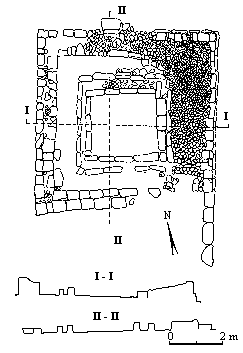
Scheme of the sanctuary of Humarin.
A feature of the Humarin gorodishte are the many runic symbols, letters
and words found on the walls and other buildings. They have been written
not only after but also during the process of construction of the fortress
- graffiti were found embedded into the wall ashlar blocks [17],
some symbols were found even under the mortar coat. Most frequent are bipods
and tridents, swastikas, the letter X and H as well as the very characteristic
for the Proto-Bulgarian finds along the Danube letter Y.
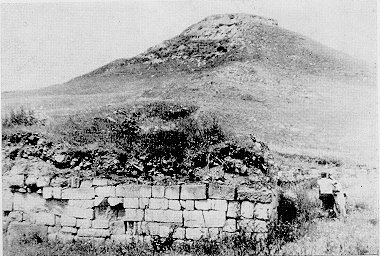
The Humarin gorodishte. The tower next to the gate
with ashlar blocks. At the far end - the citadel of the fortress.
Even the first investigator Kuznecov pointed out that the finds of Humarin
are close to those of the Saltovo-Majack culture, which belong to the Proto-Bulgarians.
The pottery does not differ from the Saltovo-Majack examples from the Azov
lands. The numerous runic letters and even words, as well as the specific
graffiti also point to the Proto-Bulgarians. The Humarin gorodishte was
dated by its pottery to the VIII-X c. [18]. The insufficient
excavations and the absence of a studied necropolis do not allow to determine
exactly to which Proto-Bulgarian group Humarin belonged, but the traces
of an earlier Alanian settlement (IV-VII cc.) beneath the fortress show
that this Proto-Bulgarian group reached the upper course of Kuban after
the Khazar expansion of the VII c. and as a result of that expansion.
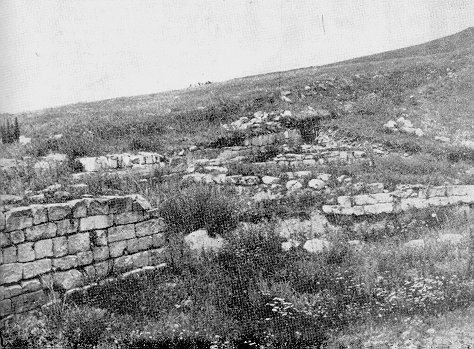
Part of the fortified wall of Humarin and the pagan
sanctuary next to it.
The Humarin gorodishte is a very important example of the Proto-Bulgarian
culture. It represents the earliest occurrence of the monumental Proto-Bulgarian
constructions of the quadra type technique. That technique differs sharply
from the coeval and the earlier local, mainly Alanian, fortresses of the
central Fore-Caucasus. The building technique was apparently borrowed from
the countries to the south of the Caucasus and from the Near East, where
the quadra technique was quite common. Similar to Humarin is also the fortress
of Derbend, where some Proto-Bulgarian presence, even if episodical, is
attested by the pottery and the characteristic graffiti of horses and riders.
Indeed, there are differences between Derbend and Humarin - the quadras
of Derbend are much more uniform in size and form perfectly horizontal
rows, tied by mortar and with good foundations. In Humarin the size of
the quadras varies, the rows are uneven, mortar is rarely used. The constructors
could not even lay foundations, they had just levelled the ground without
even removing the soft soil layer. That made them build the walls very
thick - 5-6 m. The barbarian way of building points that the construction
was a work of former nomads with no previous experience. Only the Proto-Bulgarians
could be these nomads.
As early as at the end of the last century F. Miller advanced the hypothesis
that the name of one of the Turkic peoples of the region - the Balkarians,
has preserved the ethnicon of the ancient Bulgars [19].
His argumentation was accepted almost unanimously by the scholars, who
admitted the Proto-Bulgarian contribution to the ethnogenesis of the Balkarians
[20]
and the akin to them Karachais, inhabiting the upper course of Kuban [21],
where Humarin is situated. The archaeological and documentary data unambiguously
confirm the presence of Kuban Bulgars in the valley of Kuban and in Balkaria,
where they mixed with and assimilated the remains of the earlier Alanian
population [22] There are, however, disagreements between
the scholars who give prominence to the Proto-Bulgarian contribution [23]
and those scholars, who think that the later Cumans (Kipchaks) have played
the predominant role in the ethnic make up of the Balkarians and the Karachais
and their language [24].
[Previous] [Next]
[Back to Proto-Bulgar Page]
References:
[1] S.A. Pletjnova. Drevnie bolgarii,
s. 13, 15.
[2] S.A. Pletnjova. Srednevekovaja keramika
Tamanskogo gorodishta, s. 5, 66-68.
[3] K.P. Patkanov. Iz novogo spiska
..., s. 29.
[4] V.A. Kuznecov. Glinjaniie kotlii
Severnogo Kavkaza. - Kratkie soobshtenijaInstituta arheologii AN SSSR,
99, 1964, s. 34, 38-39.
[5] Ja. A. Fjodorov, G.S. Fjodorov.
Rannie tjurki na Severnom Kavkaze, s. 71-73.
[6] V.B. Kovalevskaja. Arheologcheskie
sledii prebiivanija drevnih bolgar..., s. 50.
[7] L. Bobcheva. Glineni kotli ot rannosrednovekovnoto
selishte pri s. Topola, Tolbuhinski okryg. - Izvestija na Narodnija muzej
- Varna, XVI (XXXI), 1980, s. 126-130.
[8] V.A. Kuznecov. Alanskie plemena
Severnogo Kavkaza, s. 80-81.
[9] E.I. Krupnov. Otchet o rabote arheologicheskoj
ekspedicii 1947 g. v Kabardinskoj ASSR. - Uchen. zap. Kabardinskogo NII,
IV, Nal'chik, 1948, s. 317-318.
[10] H.H. Bidzjiev, A.V. Gadlo. Raskopki
Humarinskogo gorodishta v 1947 godu. - V: Arheologija i etnografija Karachaevo-Cherkessii,
Cherkesk, 1979, s. 27.
[11] V.A. Kuznecov. Nadpisi Humarnskogo
gorodishta. - Sovetskaja Arheologija, 1963, No 1, s. 298-305.
[12] N.H. Tatorkulov. Raskopki gorodishta
Humara. - Arheologicheskie otkriitija 1977 g., M., 1978, s. 107-108.
[13] Peter Karasimeonov. Neue Ausgrabungen
in der Residenz von Pliska. - Izvestija na Bylgarskija arheologicheski
institut, XIV, 1940-1942, S. 162, Abb. 229, 236.
[14] St. Mihajlov. Dvorcovata cyrkva
v Pliska. - Izvestija na Arheologicheskija institut, XX, s. 229-264.
[15] J. Gospodinov. Razkopki v okolnostta
na Preslav. - Izvestija na Varnenskoto arheologichesko druzhestvo, VI,
1916-1918, s. 158-159;
N. Mavrodinov. Prouchvane na cyrkvata vyv "Vynkashnija
grad" na Preslav. - Godishnik na Narodnija muzej - Sofija, V, 1933, s.
223-228.
[16] D. Ovcharov. Prabylgarskite
kapishta - proizhod i prednaznachenie. - Vekove, XII, 1983, kn. 2, s. 56-62.
[17] H.H. Bidzhiev, A.V. Gadlo. Opt.
cit., s. 46.
[18] H.H. Bidzhiev. Humarinskoe gorodishte
(VIII-X vv.). - V: Sbronik v pamet na St. Vaklinov, S., 1984, s. 122-123.
[19] V.F. Miller. Osetinskie etjydii,
t. III, M., 1887, s. 60.
[20] The modern Balkarians inhabit
several mountain valleys in the central Fore-Caucasus, at the territory
of Kabardnino-Balkarian ASSR. They number around 50,000 people.
[21] Karachais inhabit the upper cource
of Kuban, the hightermost part of Caucasus next to Elbrus. According to
the cencus of 1970, they number 112,711 people.
[22] E.P. Alekseeva. Nekotoriie zamechanija
po voprosu proishozhdenija balkarcev i karachaevcev, s. 103-106. - V: Sb.
materialii nauchnoj sessii po probleme proishozhdenija balkarskogo i karachaevskogo
narodov (22-26 ijunja 1959 g.). Nal'chik, 1960.
[23] A.H. Sottaev. Proishozhdenie balkarcev
i karachaevcev po danniim jaziika, s. 83, 94 - V: Cb. materialii nauchnoj
sessii po probleme ..., Nal'chik, 1960.
[24] L.I. Lavrov. O nekotoriih etnograficheskih
danniih po voprosu proishovdenija balkarcev i karachaevcev. s. 66-67;
T.H. Kumiikov. Etnogenezis balkarskogo i karachaevskogo
narodov v istoricheskoj literature, s. 22-24. - V: Sb. Materialii nauchmoj
sessii po probleme ..., Nal'chik, 1960.




